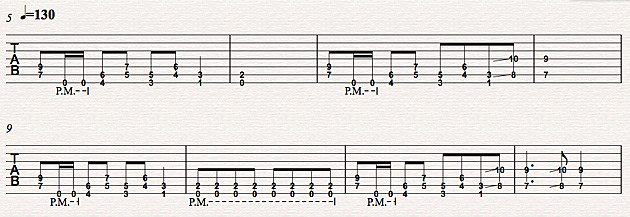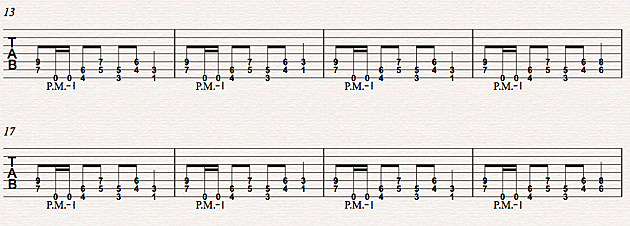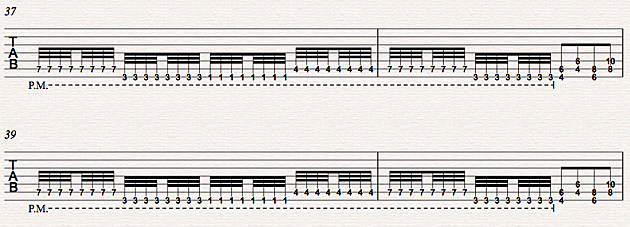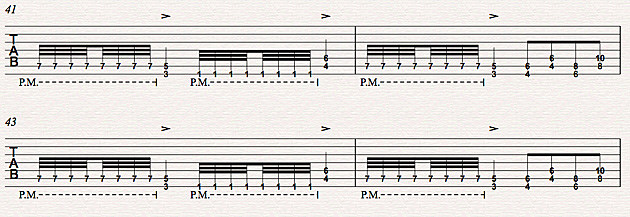
Riffage: Carcass - "Inpropagation"
Carcass’ apex is 1991’s Necroticism: Descanting the Insalubrious. Nothing against what came before (or the essential album that followed), but it is where Carcass realized how to be Carcass. A large part is due to Bill Steer’s immaculate riff architecture. He carefully constructs each song out of one or two Alpha riffs that splinter into a half-dozen others. In those variations, Carcass dredge all the sentiments nascent in one chord sequence, eking out the simple, the ugly, the abstruse, the triumphant, and the bludgeoning from below the surface.
To prepare, tune down a fourth to “B” (B, E, A, D, G, B). I recall Bill Steer favoring a medium jazz gauge, .012-.056, for his 6-string guitar (this was still a few years before Korn and the widespread availability of 7-strings). If you’re interested in total gear orthodoxy, check out producer Colin Richardson spilling the beans here. Any high-gain amp not constructed to Eddie Van Halen’s specifications will do fine.
[audio: CARCASS_INPROPAGATION.mp3]. . .
(0:47)
. . .
When the creepy industrial gauze that opens “Inpropagation” gives way to a storm of guitars, it’s easy to get swept up in the exhilarating violence without acknowledging the strategy of the attack. Those two riffs are light and shade versions of the same progression: the first, a thunderclap chord salvo to part the clouds of the intro; the next, a machine gun tremolo articulating the same phrase with scalpel-sharp precision.
. . .
(0:58)
. . .
Now the first verse riff in earnest, a distillation of the intro with emphasis on a new chord, the minor 9th of the root, a hefty C in the last beat of the phrase. This riff is the thesis statement of “Inpropagation”. Its asymmetry would be more glaring if it weren’t for the rocksteady mid-tempo pacing and the tight ‘n’ bright quadrupled rhythm guitars.
. . .
(1:12)
. . .
Things are starting to tense up. Man, that’s a fucked-up tangle of chords that sounds all the more fucked without the breath of the low B between them. The cycle repeats, the drums pick up. I think that something is arriving…
. . .
(1:26)
. . .
AAAHHH! A welcome release of major 9th arpeggios, dazzling with the added texture of synth. Notice we’re still sticking with the same remarkably skewed chord patterns found in the previous riffs, further distilled to a four chord figure with a pickup around the low B. This respite will be brief. We’re about to re-engage the grind.
. . .
(1:45)
. . .
Things pick up in a flurry of chords, a seemingly haphazard rearrangement of the Alpha riff. Then the riff is reiterated with some tags of those major 9th chords from the previous motif. At this point, the song’s riff variations are like an OCD man perpetually reorganizing the Library of Congress upon umpteen different criterion – first, we’ll put the books in order by date…
. . .
(1:53)
. . .
…now we’ll put them in order by jacket color according to the spectrum of visible light. Same riff now enters Grind-ville.
. . .
(2:03)
. . .
Holy shit, a third version. Mr. Steer’s really getting some mileage out of this one. Folks, this is how it’s done.
. . .
(2:12)
. . .
This is the last riff of the song’s first “cycle”. After a truncated take on the intro, we basically reprise that cycle. Of course, Bill Steer’s not playing anything EXACTLY the same, and there is an entire coda of essentially new riffs. But after ingesting the harmonic content of that opening cycle, it’s pretty easy to parse out the rest of it. That’s because there IS a logic to it, and that’s what’s most maddening/brilliant about this song. The meticulous compositional aesthetic in this family of atonal death metal riffs has less in common with Slayer and more with a Wagner opera. Not that that makes it better, but it’s heartening to know that an amazing song like this probably took a while to put together. That time and care result in riffs that are equal parts technicality and abandon without being a monument to either. “Inpropagation” is the sound of a guitarist taking a good long whittle at his idea – taking chances, going down wrong paths, and ultimately reaching a forest of epiphanies.



















